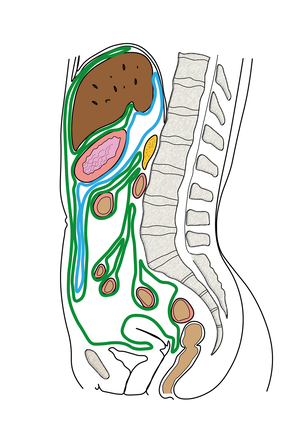Peritoneum
Peritoneum or peritoneum is a shiny serous membrane, covered by a single-layered epithelium mesothelium, which lines the abdominal cavity.[1] Under the peritoneum there is a subserosa, which fixes the peritoneum to the substrate.
On the anterior abdominal wall posteriorly in the tela subserosa, 3 ligamentous bands run from the bladder to the umbilicus, which are the remnants of the urachus and umbilical arteries. They form 3 plexuses : plica umbilicalis mediana, medialis dx. et sin.
They divide into:
a) peritoneum parietale - in the form of duplicates, necks, ligaments passes to the organs in the abdominal cavity
b) peritoneum viscerale - the peritoneum
The cavity between the two peritoneums cavitas peritonealis is filled with a small amount of fluid liquor peritonei.
According to their relationship to the peritoneum, organs are divided into : intraperitoneal, retroperitoneal, subperitoneal, extraperitoneal and secondary retroperitoneal
Hernia :
a)direct - anulus inguinalis superficialis, fossa inguinalis medialis
b)indirect - anulus inguinalis profundus then through the canalis inguinalis to the anulus inguinalis superficis, fossa inguinalis lateralis
Breakdown of the peritoneal cavity[edit | edit source]
- pars supramesocolica (above the mesocolon transversum, between the mesocolon and the diaphragm):
- spatium subphrenicum dx. et sin. (mezi bránicí a játry);
- spatium subhepaticum dx. et sin.;
- bursa omentalis (communicates with the right subhepatic space via the for. epiploicum).
Hranice bursa omentalis : ventral - stomach, omentum minus and lig. gastrocolicum, dorsal - parietal peritoneum, pancreas, great vessels, left kidney and adrenal gland, caudal mesocolon transversum
2. pars inframesocolica
The course of the radix mesenterii and the confluence of the colon ascendens and colon descendens and also the mesocolon transversum form 4 spaces:
- right adhesive field - cranial is mesocolon, right is colon ascendens and caudal is radix
- left adhesive field - cranial mesocolon, right radix mesenterii, left colon descendens
- right and left paracolic space - lateral side of colon descendens/ascendens
Organ Ligaments[edit | edit source]
- v pars supramesocolica:
- coming from the mesogastrium dorsale:
- lig. phrenicolienale;
- lig. gastrophrenicum;
- lig. gastrolienale;
- lig. gastrocolicum;
- omentum majus - from curvatura gastrica major, has 2 leaves , the anterior one descends caudally in front of the transverse part of the colon, the posterior leaf returns upwards and attaches to the taeniae omentales of the colon
- arising from the mesogastrium ventrale:
- omentum minus (lig. hepatooesophagicum, lig. hepatogastricum et hepatoduodenale); - duplication between the curvature gastrica minor and the visceral surface of the liver
- lig. falciforme hepatis (in its continuation - lig. coronarium dx. et sin. et lig. triangulare dx. et sin.).
- coming from the mesogastrium dorsale:
- v pars inframesocolica:
- mesenterium;
- mesoappendix;
- mesocolon transversum - colon transversum
- variably mesocolon ascendens, descendens, sigmoideum and mesorectum.
Peritoneal recessions[edit | edit source]
Peritoneal recessions are blind pockets in the peritoneal cavity. They are sites of possible internal henia formation.
- in the duodenojejunal flexure area:
- rec. duodenalis sup. et inf. Treitzi;
- rec. retroduodenalis Waldayeri;
- rec. paraduodenalis (sinister, venosus - runs here v. mesenterica inf.) Gruberi-Landzerti.
- in the area of the ileocecal transition:
- rec. ileocaecalis sup. et inf.;
- rec. retrocaecalis;
- recessus paracolici;
- recessus intersigmoideus Treitzi.
Vascular supply[edit | edit source]
blood vessels of those organs which are surrounded by it
Nerve supply[edit | edit source]
Autonomic vasomotor nerves, the visceral is supplied autonomically and the parietal sensory innervates the n.phrenicus, nn. intercostales and plexus lumbalis
Links=[edit | edit source]
External links[edit | edit source]
Source[edit | edit source]
- ČIHÁK, Radomír a Miloš GRIM. Anatomie 2. 2. vydání. Praha : Grada Publishing, 2009. ISBN 80-247-0143-X
Reference[edit | edit source]
- ↑ ČIHÁK, Radomír a Miloš GRIM. Anatomie. 2. upr. a dopl vydání. Praha : Grada Publishing, 2002. 470 s. sv. 2. ISBN 80-247-0143-X.


